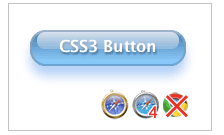CSS3 Gradients: No Image Aqua Button
Note (Jan 28, 2010): I added a Firefox support to this tutorial. Please visit the “revisited” article too!
Boooo, Yahoo! just had the 3rd round of layoff within a little over a year period, and this time I was axed with several more fellow excellent engineers of Mobile team. So now I have free time to spend on more coding!
My job function needed full focus on products and it prevented me to have experiments and testing as I wanted to, so I always spent my own time to do. Now I can do whatever I want to while I am still on payroll. Yes! I am still paid my regular salary for a while, thanks for the new regulation ![]()

OK, enough blah about the stupid corporate stuff.
Anyway, I played around with WebKit CSS3 gradient and created a useless but fun stuff – an Aqua button with no images!
Back in the time when Mac OS X was first announced, there’re a plenty of web tutorials that describe how to create the sexy aqua button with Photoshop, and now I can show how to create one with CSS!
Here’s a screen capture of the rendered button. You can see the actual HTML page too.
OK, let’s take a look at the code:
<div class="button aqua">
<div class="glare"></div>
Button Label
</div>
Create a Button Base and Styling Label
.button{
width: 120px;
height: 24px;
padding: 5px 16px 3px;
-webkit-border-radius: 16px;
-moz-border-radius: 16px;
border: 2px solid #ccc;
position: relative;
/* Label */
font-family: Lucida Sans, Helvetica, sans-serif;
font-weight: 800;
color: #fff;
text-shadow: rgba(10, 10, 10, 0.5) 1px 2px 2px;
text-align: center;
vertical-align: middle;
white-space: nowrap;
text-overflow: ellipsis;
overflow: hidden;
}
The first part to render a rounded-corner rectangle. Set the position as relative to place “glare” inside of the button later.
The second part is for styling the label.
Give text-shodow with alpha-transparency. (Believe or not, Chrome and Android do not support text-shadow!)
Button Color and Shadow
.aqua{
background-color: rgba(60, 132, 198, 0.8);
background-image: -webkit-gradient(linear, 0% 0%, 0% 90%, from(rgba(28, 91, 155, 0.8)), to(rgba(108, 191, 255, .9)));
border-top-color: #8ba2c1;
border-right-color: #5890bf;
border-bottom-color: #4f93ca;
border-left-color: #768fa5;
-webkit-box-shadow: rgba(66, 140, 240, 0.5) 0px 10px 16px;
-moz-box-shadow: rgba(66, 140, 240, 0.5) 0px 10px 16px; /* FF 3.5+ */
}
Now, specify the appearance of the button and shadow at bottom.
Here. I use the -webkit-gradient to create a nice-looking aqua gradient.
Notice that I use -webkit-gradient as a background-image, although there’s no physical graphics are added there.
You can use gradients in background-image, border-image, list-style-image and content property.
On Firefox, this is ignored and you see only Background-color.
The syntax for linear gradient is as follows:
-webkit-gradient(lenear, left top, right bottom, from(start color/alpha), to(end color/alpha))
In this example, starts with dark blue from straight top to bottom (no angle) at 95%, not all way down, to blended into lighter blue.
Then, I specified color on each border (so the css looks pretty messy).
Finally, give a nice shadow at bottom, with -webkit-box-shadow.
Firefox 3.5+ supports it too, so duplicate it with -moz-box-shadow.
Syntax is as:
[color/alpha] [horizontal offset] [vertical offset] [blur radius]
Give it shine
.button .glare {
position: absolute;
top: 0;
left: 5px;
-webkit-border-radius: 8px;
-moz-border-radius: 8px;
height: 1px;
width: 142px;
padding: 8px 0;
background-color: rgba(255, 255, 255, 0.25);
background-image: -webkit-gradient(linear, 0% 0%, 0% 95%, from(rgba(255, 255, 255, 0.7)), to(rgba(255, 255, 255, 0)));
}
The class glare renders the glossy look on the button.
First, give absolute position to the parent container, button to give shine in the right position.
Again, use -webkit-gradient to create the glossy look, by playing with alpha-transparency.
Start with the white (alpha 0.7) and end with complete transparent (alpha 0).
Honestly, I do not like to have this non-semantic empty div block to only get this visual effect.
I need to figure a better way to do.
References:
- Safari Reference Library – CSS Property Functions by Apple
- Surfin’ Safari – Introducing CSS Gradients
- Mozilla Extensions</li> </ul>
comments powered by
